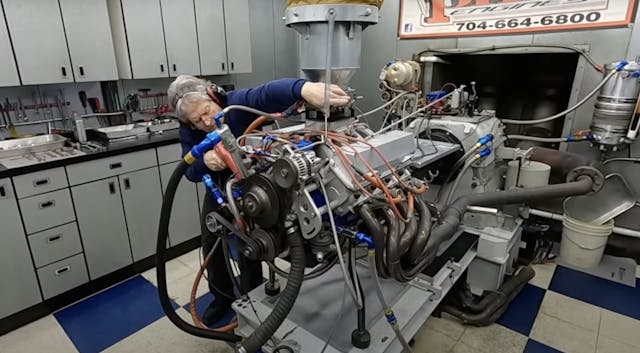Media | Articles
Busting storage myths with long-dormant NASCAR V-8
Some of the most strongly held opinions in the classic car world surround the matter of vehicle storage. Unfortunately, these opinions are difficult to evaluate: Though we may have a decent understanding of how our cars and their engines work, we may lack the ability to test all the theories and opinions regarding their “proper” storage. And who would risk mistreating a treasured vehicle?
That’s why it’s great when someone shares detailed, first-hand experience. The latest example concerns a small-block Ford built for a NASCAR stock car that ended up living on the shop floor for nearly 20 years. We get to compare its power output before and after storage, using the dyno sheet when it was built in 2004 and comparing that to present-day results. For the “after” dyno run, the engine receives no prep other than a little oil in the cylinders.
The experiment comes courtesy of Stapleton42 on YouTube, who was tipped off to a long-stored but freshly built Ford C3 engine. It was built, broken in, and made power pulls on the dyno before it was crated up and left to sit. No turning over from time to time. No special lubes. Just an engine sitting on the floor.
So how much power did the engine lose after all those years of “improper” storage?
Marketplace
Buy and sell classics with confidence
None.
You’re either not surprised by this at all, or you’re shocked the engine didn’t grenade itself once up to temperature.
Let’s discuss each reaction individually.
Reaction 1: Nonplussed.
Simply sitting on a shop floor doesn’t put any wear on the internal parts of an engine. Worst-case scenario, the piston rings rust to the cylinder walls, or other corrosion creeps in and causes additional friction in unexpected places.
This situation likely cures itself, as those piston rings are essentially scraping the bore of the cylinders clean with each stroke. The engine likely was down a bit of compression on first startup, but after just a few moments of running, all that corrosion was put into the oil and caught in the filter. No big deal.
Reaction 2: Shock.
If you’re in this camp, you’ve thought about the situation and are less focused on the big picture issues and more on the details.
The nature of a pushrod V-8 means that no matter where the crankshaft stops in its rotation, some valves—each of which opens and closes via springs—will be held open. You’d expect that keeping a spring compressed for 19 years would be detrimental to it. The dyno operator in the video points out that is only part of the problem: When roller lifters are used, the lifter—more specifically, the bushing or bearing at the lifter’s tip—has been under pressure for decades. This component is more likely to cause a problem than an over-compressed spring: if the bearing is slightly bound up and refuses to rotate properly, the camshaft could wipe a lobe on startup.
While this diagnosis is pretty specific to race engines, we extrapolate the principals to barn finds or otherwise “lost and found” vehicles that have sat for years. The bits and pieces in cars are often far more durable than we give them credit for and if the relatively delicate race engine pieces survive this kinda of neglect, a consumer-grade engine likely will have even less trouble; these are built to withstand a larger amount of neglect, in most cases.
Will this NASCAR engine now run forever without any further maintenance? Maybe. Only time would tell, but most everyone involved agrees that some amount of teardown and inspection would be wise. The low cost of gaskets could save the high cost of destroyed parts. A little caution never hurt anyone, especially an engine builder.
***
Check out the Hagerty Media homepage so you don’t miss a single story, or better yet, bookmark it. To get our best stories delivered right to your inbox, subscribe to our newsletters.



The experiment would need to go the next step of putting the engine into use and then seeing how it holds up. Being a race engine not sure if you can recreate a data set.
If it was a civilian spec engine you would just drop it in a car and try and put 100000 miles on it.
I’m hoping that I will be as lucky. I’m in the process of buying a car that was restored 30 years ago. PO drove the car around the block once and promptly put it in his basement where it sat for the next 30 years. I really hope I don’t have to tear down the engine.